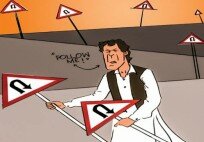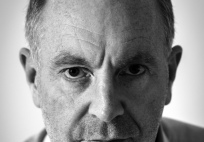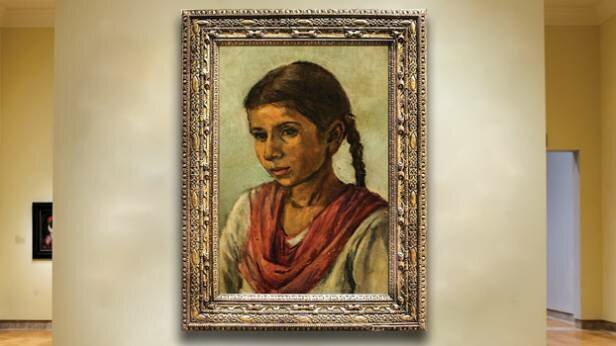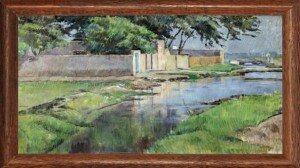By Nadeem Alam –
Khalid Iqbal: The father of modern realism in landscape painting in Pakistan
Landscape painting has always been a popular and undisputedly, the most acceptable genre of visual arts among all and sundry in Pakistan. Owing to its natural and gifted beauty, the plains of Punjab have invariably attracted the onlookers, as well as the painters, to pay homage to the enriched colours, captivating light and in-depth perspectives of orange and red horizons of dawn and dusk.
The Pahari miniatures use the vegetation of green mountains as the ornate backdrop behind the sensuously romantic couples, or the lonely female waiting for his mate, in the vast blue of night or absorbing lush green of the day.
Then, it was the company painters of the colonial era who brought the modern and realistic technique of landscape painting to the subcontinent preferably through the mediums of oil colour and watercolour. The realistic style owing to its capacity of imitating the naturalistic rendering of the seen-objects, received popularity and acceptance among the local artists and the genius of Allah Bakhsh responded to the depth and illusions created by the geometrically enhanced perspective, a new approach in for the regional painters and viewers.
In the subcontinent, with the commencement of academic art in the newly established art institutions, many Western techniques in the landscape painting were introduced in terms of medium and style. During this period, the cityscape painting established its stronghold; Anna Molka and Naseem Hafeez Qazi captured the architectural patterns and the street-culture of the Old-city Lahore.
In this visual culture, a determined young painter, Khalid Iqbal came back to Lahore after studying at the Slade School of Arts, London under the scholarship and wisdom of Sir William Coldstream, who was a torchbearer of a relatively new visual idiom in the landscape painting in England; the Modern Realism. Khalid iqbal brought the Modern Realism to Pakistan and adopted it in his own style in a manner that very soon; he was being followed and admired by his students and contemporaries.
Khalid Iqbal was born on 23rd June 1929 at Simla, Jammu & Kashmir. In 1945, he did his O’ Level from St. Joseph’s Academy, Dheradun; the capital of the state of Uttarakhand in the northern part of India, located at about 236 km north of Indian capital New Delhi. By 1948, he was taking Art lessons from Sheikh Ahmad; the husband of Anna Molka Ahmad. In 1949, Khalid did his BA from Forman Christian (FC) College Lahore and joined Atchison College Lahore as an Art Teacher. In 1952, he did a diploma in French from the Oriental College Lahore and the same year he went on to study fine arts at the renowned Slade School of Arts, University of London, UK. From 1956 to 1965, he served the Fine Arts Department of the University of the Punjab as a senior lecturer.
In 1965, he joined the National College of Arts as Associate Professor and Head of the Fine Arts Department, and after almost a decade in 1974, he was promoted as the acting Principal of the NCA. He served the NCA until his retirement in 1981. At NCA, he was honoured with the Chair of Professor Emeritus in 1993. Khalid Iqbal has been conferred upon the Quaid-e Azam Award in painting in 1977 and the President’s Medal for Pride of Performance in 1980.
Khalid’s association with nature and vegetation can be traced back to his early childhood in Simla and then his academic years at Dheradun. Both locations were beautiful and matchless with the green-mountain backdrops of the Himalayas. In this perspective, it has remained an interesting fact that mostly in his painting career. Khalid has been painting the dusty and hazy plains of Punjab with subdued colours and refracting sunlight. Khalid’s main emphasis has always been on how nature appears at the painter, rather how the painter sees her. This became his basic approach towards landscape painting, which is titled as the Modern Realism.
Modern Realism is based on the effect of light on the painter in terms of his or her perception of a particular spot where he or she stands to paint. Khalid Iqbal suggests that the observation and time-spending at the spot which the painter wants to paint, can help as well as affect the palette and the approach of the painter, even before he or she would commence the painting process. This theory inspired many of his students, especially Zulqarnain Haider, who very often, used to accompany his mentor at the same spot or place for painting landscapes.
In pursuit of rendering the effects of light in a naturalistic, instead of realistic, manner, Khalid Iqbal kept on exploring the subtle and pacified shades of oil paints by diluting them in more and more turpentine oil within his representational palette. In this pursuance, he preferred to paint on hardboard due to its soaking ability in place of traditionally used canvas; that was considered more suitable surface for relatively thick paints. Mostly, Khalid’s frames are of small sizes that exhibit the painter’s exactitude towards his observation and rendering as a Modern Realist. In other words, we can say that Khalid Iqbal, as a painter, is extraordinarily sensitive towards the nature and appearance of colours therefore, he applies them very carefully without letting any shade of any used colour to scream or shout loudly; he only lets his colours to whisper or murmur! However, the intensity of expression is always a priority, even in the subdued tonalities.
Other than painting landscapes, Khalid Iqbal also carried out some portraits and few still-life paintings. His portrait painting has encompassed Anna Molka Ahmad, Colin David and Zulqarnain Haider and some of the interesting faces like a maid Babbi or portrait of an old man. One still-life painting with a human skull is quite well known.
Khalid Iqbal placed, neither his signatures nor a date on his paintings. This attitude is painstaking for many critics and art-historian, but on the other hand, it seems that Khalid is never bound by the time or space. He is more concerned with the effects or the atmosphere that he succeeds in creating on a heard-board surface by spellbinding the onlooker with delicate colours that mystify the appearance of his paintings.
The writer teaches Art History at the Punjab University College of Art and Design, Lahore. He can be reached at [email protected]

































































































